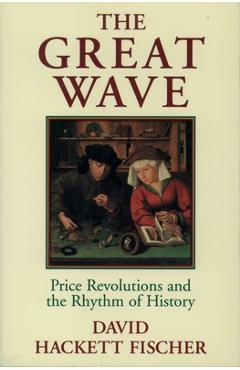
Fischer has examined price records in many nations, and finds that great waves of rising prices in the 13th-, 16th-, 18th-, and 20th centuries were all marked by price swings of increasing volatility, falling wages, a growing gap between rich and poor, and an increase in violent crime, family disintegration, and cultural despair.
109 graphs & charts.
7 maps.
David Hackett Fischer, one of our most prominent historians, has garnered a reputation for making history come alive--even stories as familiar as Paul Reveres ride, or as complicated as the assimilation of British culture in North America.
Now, in The Great Wave, Fischer has done it again, marshaling an astonishing array of historical facts in lucid and compelling prose to outline a history of prices--the history of change, as Fischer puts it--covering the dazzling sweep of Western history from the medieval glory of Chartres to the modern day.
Going far beyond the economic data, Fischer writes a powerful history of the people of the Western world: the economic patterns they lived in, and the politics, culture, and society that they created as a result.
As he did in Albions Seed and Paul Reveres Ride, two of the most talked-about history books in recent years, Fischer combines extensive research and meticulous scholarship with wonderfully evocative writing to create a book for scholars and general readers alike.
Records of prices are more abundant than any other quantifiable data, and span the entire range of history, from tables of medieval grain prices to the overabundance of modern statistics.
Fischer studies this wealth of data, creating a narrative that encompasses all of Western culture.
He describes four waves of price revolutions, each beginning in a period of equilibrium: the High Middle Ages, the Renaissance, the Enlightenment, and finally the Victorian Age.
Each revolution is marked by continuing inflation, a widening gap between rich and poor, increasing instability, and finally a crisis at the crest of the wave that is characterized by demographic contraction, social and political upheaval, and economic collapse.
The most violent of these climaxes was the catastrophic fourteenth century, in which war, famine, and the Black Death devastated the continent--the only time in Europes history that the population actually declined.
Fischer also brilliantly illuminates how these long economic waves are closely intertwined with social and political eve.
Honobonoru500
91.74 Lei
Selena Rezvani
97.86 Lei
Moor Corporation
122.71 Lei
Rumiko Takahashi
85.62 Lei
Insight Editions
72.49 Lei
Graham Austin-King
130.12 Lei